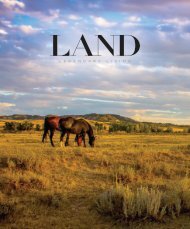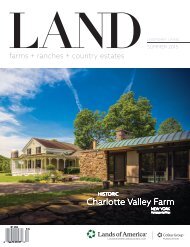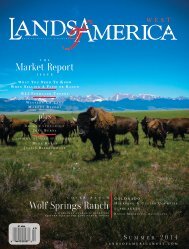Winter 2017
LAND
LAND
Create successful ePaper yourself
Turn your PDF publications into a flip-book with our unique Google optimized e-Paper software.
Farming and ranching operators may also have particularly<br />
strong convictions regarding long-established family<br />
enterprises that are heavily concentrated in real property.<br />
Many farms and ranches have been in the family for several<br />
generations, and a prevalent desire is to keep ownership of the<br />
land in the hands of family members–both those involved in<br />
operations as well as those who may not be involved. Of course,<br />
this generally gives rise to unique problems governing appropriate<br />
income apportionment, control and estate equalization.<br />
As a result, a comprehensive understanding of the relevant<br />
issues and techniques is crucial to the effective implementation<br />
of appropriate legal and tax strategies, ensuring the preservation<br />
of the farm or ranch for succeeding generations while bestowing<br />
long-term peace of mind on operators.<br />
Challenges<br />
Farm and ranching operations are especially vulnerable to poor<br />
economic conditions. Capital requirements are high and return<br />
on investment is sometimes low. Operators typically accumulate<br />
most of their equity through earnings and gradual increases in<br />
asset values from growth and inflation; net worth tends to result<br />
more from growth in the value of production assets rather than<br />
income accumulation. It is also critical for operators to maintain a<br />
debt-equity structure which assures survival through periods of<br />
adverse weather and market conditions.<br />
Likewise, agriculture also is extremely sensitive to export<br />
markets. For example, high interest rates in the 1980s contributed<br />
to a strong dollar which in turn contributed to a drop in U.S.<br />
farm exports. Farmers and ranchers were ultimately hurt by<br />
the decline in the price of agricultural products and real estate.<br />
Operators with excessive debt combined with high interest rates<br />
and low prices often did not survive during the era. For today’s<br />
farmers and ranchers to survive, maintaining financial solvency<br />
is important. For a family enterprise to thrive from generation to<br />
generation, establishing and maintaining an effective long-term<br />
plan is essential.<br />
Details of the Industry<br />
Attitudes & Outlooks<br />
Many successful family farms and ranches are built over<br />
generations, creating a deep personal bond and sense of identity<br />
in the operation. Furthermore, the physical nature of the labor<br />
that goes into building a farm often creates a unique perspective<br />
by the operator, one that may place a strong emphasis on the<br />
character, stability, and integrity that farming signifies. The<br />
fruits of the many years of labor include self respect, personal<br />
satisfaction and a tangible, permanent family legacy.<br />
Nature of Work<br />
Farming and ranching operations have become more complex<br />
in recent years. Farm output and income are strongly influenced<br />
by the weather, disease, fluctuations in prices of domestic farm<br />
products, and federal farm programs.<br />
Both farmers and ranchers operate machinery and maintain<br />
equipment and facilities, and both track technological<br />
improvements in animal breeding and seeds, and choose new<br />
or existing products. Farm work can be hazardous. Tractors and<br />
other farm machinery can cause serious injury, and operators<br />
must be constantly alert on the job. The proper operation of<br />
equipment and handling of chemicals are necessary to avoid<br />
accidents, safeguard health, and protect the environment.<br />
Operators of small farms usually perform all tasks, physical<br />
and administrative. They keep records for management and<br />
tax purposes, service machinery, maintain buildings, and grow<br />
vegetables and raise animals.<br />
Operators of large farms, by contrast, have employees who<br />
help with the physical work. Farmers on crop farms usually work<br />
from sunrise to sunset during the planting and harvesting seasons.<br />
The rest of the year, they plan next season’s crops, market their<br />
output, and repair machinery.<br />
On livestock-producing farms and ranches, work goes on<br />
throughout the year. Animals, unless they are grazing, must be<br />
fed and watered every day, and dairy cows must be milked two or<br />
three times a day. Many livestock and dairy farmers monitor and<br />
attend to the health of their herds, which may include assisting in<br />
the birthing of animals.<br />
Tailored Planning<br />
Since each family farm or ranch is unique, no single approach to<br />
estate and business planning works for everyone. It is important<br />
to understand that the farm or ranch involves the interaction of<br />
people in the strong bonds of family, who are engaged in the<br />
business and who make decisions affecting the business.<br />
It also is important that estate and succession planning adopt<br />
a long-term planning horizon and implement planning strategies<br />
in a timely and efficient manner to accomplish intended goals.<br />
Most farmers and ranchers desire that the operation continue<br />
when they are gone, though a few do not. When the operation will<br />
not be continued, the focus shifts to transferring, liquidating and<br />
distributing equity to the heirs while minimizing any loss in value.<br />
Potential Planning<br />
Issues & Concerns<br />
Since operating a farm or ranch is difficult, designing a strategy<br />
for the ultimate transition of the business upon the primary<br />
operator’s demise can be confusing. There are a variety of issues<br />
and concerns related to estate and business planning that should<br />
be addressed, the most common of which are discussed below.<br />
Farm Economics<br />
Farm economics differ from that of most other businesses. An<br />
acre of farmland might cost $5,000 but have a rental value of<br />
only $200 per year, a four percent return. Compare this with<br />
residential and commercial real estate which typically have<br />
returns in the range of eight to ten percent. This means that the<br />
current productivity of farmland is relatively low, and much of its<br />
LAND.COM • LEGENDARY LIVING<br />
69
















